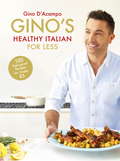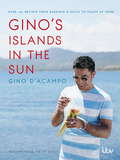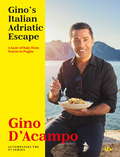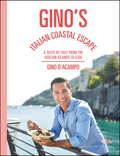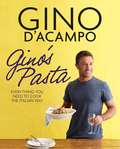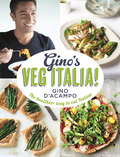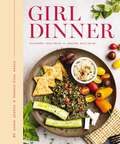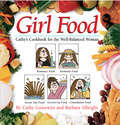- Table View
- List View
Gingerbread Murder (Frosted Love Cozy Mysteries #21)
by Summer PrescottCan a dog solve a murder? It's holiday time in the sleepy beachside town of Calgon, Florida, and cupcake baker/amateur sleuth Melissa Beckett is about to find out just how smart man's best friend can be. When an adorable stray leads her to the scene of a gruesome crime, the investigation into the reclusive victim's life begins. The victim seems to have had lots of enemies, which makes the search for a suspect much more complicated than Missy, and her dashing husband, Detective Chas Beckett, thought it might be. Meanwhile, new relationship issues abound between the busy sleuth's besties, Echo and Carla, and their new love interests, bringing drama and Laughs to the rest of the holiday craziness. Will Missy find a killer's identity under the tree this year?
Gingerbread Wonderland: 30 Magical Houses Cookies And Bakes
by Mima SinclairTurn your kitchen into a winter wonderland with Gingerbread Wonderland. With recipes ranging from simple gingerbread men and women to more detailed scenes such as houses and a carousel, Mima Sinclair's new cookbook is suitable for the whole family. It's packed with fun gingerbread biscuits, sticky gingerbread cakes, plus handy tips on how to avoid mistakes, making templates, cutting perfect lines and more. As well as the traditional Christmas favourites such as a Hansel & Gretel House, there are contemporary creations such as Mini CoffeeCup Houses, Glass Pressed Cookies and a 3D Christmas Tree. Make perfect treats to slip into lunch boxes, serve up to friends at tea, give as gifts or show off as your holiday centrepiece.
Gingerbread: 30 Magical Houses, Biscuits And Bakes
by Mima SinclairTurn your kitchen into a winter wonderland with Gingerbread Wonderland. With recipes ranging from simple gingerbread men and women to more detailed scenes such as houses and a carousel, Mima Sinclair's new cookbook is suitable for the whole family. It's packed with fun gingerbread biscuits, sticky gingerbread cakes, plus handy tips on how to avoid mistakes, making templates, cutting perfect lines and more. As well as the traditional Christmas favourites such as a Hansel & Gretel House, there are contemporary creations such as Mini CoffeeCup Houses, Glass Pressed Cookies and a 3D Christmas Tree. Make perfect treats to slip into lunch boxes, serve up to friends at tea, give as gifts or show off as your holiday centrepiece.
Gingerbread: Timeless Recipes For Cakes, Cookies, Desserts, Ice Cream, And Candy
by Jennifer Lindner McGlinnEvery season is gingerbread season! Celebrate the Christmas comfort food all year long with recipes that highlight its spicy and sweet old-fashioned appeal.Who says gingerbread is just for the holidays? This unique cookbook shows how gingerbread can be enjoyed for breakfast or dessert year-round. Reflecting the wisdom and creativity of a professional pastry chef and dedicated homecook, Gingerbread collects 60 traditional and modern recipes. Start with simple, yummy treats like Gingerbread Rum Cake and Sticky Toffee Gingerbread, then graduate to building your own gingerbread house for the holidays. Any way you slice it, these gingery goodies are sure to be a hit on any day of the year!“A book full of gingery recipes that will keep us baking all winter long . . . The recipes are exotic sounding and tasting, but can be followed by even novice cooks.” —Seed to Pantry“Dedicated to all kinds of recipes that use the spicy, molasses-rich ingredients that come together to make gingerbread . . . even though you can make these all year round, the holidays are a perfect time to start cooking your way through a book like this one.” —Baking Bites“The recipes in this wonderful cookbook cover every form of gingerbread baking, from cakes, cookies, breads, pancakes, gingerbread houses, puddings, ice cream, toffee, and more . . . Gingerbread does not have to be just for the holidays, but if you are looking for a new dessert to try this year, you can’t lose with any of the recipes in this cookbook.” —The Culinary Cellar
Gingerdead Man (A Five-Ingredient Mystery #7)
by Maya CorriganWhen Santa is sleighed by a poison gingerbread cookie at a holiday party, Val Deniston's reputation is on the line . . . This holiday season Bayport, Maryland, is a dead ringer for Victorian London. Val and her grandfather are taking part in the Dickens of a Holiday festival. Val is hosting a private tea party serving the festival's costumed volunteers, who range from Dickens divas like Madame Defarge and Miss Havisham to Ebenezer Scrooge and old St. Nick himself. But one costumed reveler may have gotten the holidays mixed up. The winner of the creepiest outfit, robed in black with a gift bag covering the head—okay, Ghost of Christmas Present, Val gets it—hands out gingerbread men with white icing skeleton bones. This year's sour Santa has none of the big fellow's mirth but plenty of his appetite, and it's no secret Santa loves cookies. But when the man in red turns blue, Val and Granddad have a cookie-cutter killer to catch before the New Year . . . Includes delicious five-ingredient recipes! PRAISE FOR CRYPT SUZETTE "Grandad is a hoot and his jobs as a food reviewer and part-time detective provide endless possibilities for fun and murder . . . Charming." —Kirkus Reviews
Ginnie and Geneva
by Catherine Woolley[From the dust jacket:] "Ginnie had not started going to school as early as other children, but because of her mother's lessons she was ready for fourth grade. Although she had looked forward to school eagerly, it was a disappointment at first, for she hadn't played games or roller skated or had any practice in comradeship of boys and girls. Geneva Porter, the most confident and popular girl in the class, bothered Ginnie most of all, for Geneva loved to tease. But Ginnie, who found it hard to defend herself, had no trouble at all in standing up for another little girl. This is a warm and understanding story of children learning to get along with each other and having a wonderful time as they do." Don't miss the other great books in the Ginnie series. Bookshare has them including: Ginnie's Babysitting Business, Ginnie's Mystery Cat and Ginnie and the Mystery Doll.
Ginnie and the Cooking Contest
by Catherine Woolley"When Ginnie spotted the newspaper headline announcing a juvenile cooking contest, she was immediately fired with enthusiasm and determination to win first prize, a trip to Washington, D. C. For weeks she pored over a multitude of cookbooks trying to find the ideal menu to submit and a superlative recipe to prepare the day of the contest. Although an experienced cook for her age, Ginnie began to lose confidence as she sampled her friends' mouth-watering dishes and still could not decide on her own entry. Even with her plans settled, Ginnie found she had not allowed enough time to prepare her material. How she manages to enter the contest on time, and what happens then, makes a suspenseful climax to a warm, appealing story. Ginnie's refreshingly natural personality has won her many loyal fans. This new book about her, illustrated with charming line drawings, is one of the most enticing. Ginnie's experiments with cheese soufflé, homemade bread, and chicken loaf are described with relish, and they are guaranteed to turn every reader into an eager cook." You can read much more about Ginnie and her friends in Ginnie and Geneva, Ginnie's Baby-sitting Business and Ginnie and the Mystery Cat and more in the Bookshare collection.
Gino's Healthy Italian for Less: 100 feelgood family recipes for under £5
by Gino D'AcampoWant to cook like a true Italian and stick to the budget? Look no further than these 100 authentic and simple meals from the heart of Italy.Gino will teach us how to cook like a true Italian, but this time on a budget! Full of money-saving tips and tricks, to create delicious, healthy Italian meals at home - brimming with fresh ingredients with the same big flavours, in his simple signature style. Learn how to shop smart and store food, make the most of your fridge / freezer, and fill your kitchen cupboards with fail-safe Italian basics. Bring down the cost of your weekly shop and start eating better than ever with Gino's Healthy Italian for Less.
Gino's Healthy Italian for Less: 100 feelgood family recipes for under £5
by Gino D'AcampoWant to cook like a true Italian and stick to the budget? Look no further than these 100 authentic and simple meals from the heart of Italy.Gino will teach us how to cook like a true Italian, but this time on a budget! Full of money-saving tips and tricks, to create delicious, healthy Italian meals at home - brimming with fresh ingredients with the same big flavours, in his simple signature style. Learn how to shop smart and store food, make the most of your fridge / freezer, and fill your kitchen cupboards with fail-safe Italian basics. Bring down the cost of your weekly shop and start eating better than ever with Gino's Healthy Italian for Less.
Gino's Hidden Italy: How to cook like a true Italian
by Gino D'AcampoJoin the nation's favourite Italian chef, on his journey of discovery through Northern Italy, to reveal the secrets of real Italian food. From peach picking in Turin to truffle hunting in Piedmonte, Gino celebrates the best in local and seasonal Italian ingredients. Using traditional methods found in the kitchens of Italy, this book will introduce Gino's fans to 80 delicious new recipes, that will bring authentic Italian dining to your family table. It will accompany Gino's new 7-part primetime series Hidden Italy, coming to ITV this Autumn. Chapters include:Antipasti & Soups; Pasta; Risotto; Fish & Seafood; Poultry & Meat; Vegetables & Sides; Pizza, Pies & Bread; Desserts
Gino's Islands in the Sun: 100 recipes from Sardinia and Sicily to enjoy at home
by Gino D'AcampoJoin Gino on his trip to the islands of Sicily and Sardinia on a journey of discovery of authentic and delicious Italian food. Delving into the gastronomic history of these islands he will uncover the signature dishes, and secret recipes that encapsulate Sicily and Sardinia and their people.With over 100 mouth-watering recipes - using fresh ingredients and regional specialities - Gino's Islands in the Sun will reveal the culinary secrets of these Mediterranean islands.
Gino's Italian Adriatic Escape: A taste of Italy from Veneto to Puglia
by Gino D'AcampoJoin Gino on his culinary journey along the picturesque Adriatic coast. Gino's Italian Adriatic Escape, from everyone's favourite Italian chef, explores the cuisine of the beautiful East coast of Italy. A celebration of the finest recipes from the Adriatic coast, this cookbook makes Italian cooking simple. It includes everything from fresh seafood to delicious pasta, vegetarian options to meat dishes, and the exquisite photography is guaranteed to give you wanderlust. Gino's Italian Adriatic Escape includes all of the mouth-watering recipes from the accompanying major ITV series, as well as introducing us to some new delicious Italian recipes which are perfect for a meal for one or a family feast.
Gino's Italian Coastal Escape: A Taste of Italy from the Aeolian Islands to Elba
by Gino D'Acampo'I know that some of you may never visit Italy, but with these simple and delicious recipes, which were inspired by my recent trip, I can bring a little bit of Italy to you.'Just back from his epic journey along Italy's stunning west coast for the ITV series Gino's Italian Coastal Escape, everyone's favourite Italian chef reveals the wonders of one of the richest and most varied cuisines in the world.Drawing inspiration from the markets and kitchens he visited and the locals he met, Gino has brought together these authentic regional recipes for you to recreate easily at home. Many are seafood classics, such as Amalfi-style fish soup and spaghetti vongole, but there is a wide range of other savoury dishes and sumptuous desserts. In addition, Gino shares some family recipes that he enjoyed when growing up in Campania, including his mother's meatballs and father's spicy calzone.All the recipes perfectly capture the essence of Italy's beautiful coastline and will have you cooking and eating like an Italian in no time.Chapters will include: Antipasti; Pasta and Rice; Pizza; Fish; Shellfish and Seafood; Poultry and Meat; Salads, Sides and Accompaniments; Desserts.
Gino's Italian Escape
by Gino D'AcampoDiscover the secrets of real Italian food with Gino D'Acampo as he captures the flavours, smells and tastes of his homeland in over 100 deliciously simple recipes. From much-loved pizza, pasta and antipasti dishes, to Gino's classics with a twist such as Honey & Rosemary Lamb Cutlets and Limoncello Mousse, this book is packed with mouth-watering favourites that will soon have you cooking and eating like a true Italian.Accompanying a major ITV series, Gino's Italian Escape is a celebration of the very best Italian food from one of the country's favourite exports.
Gino's Italian Escape (Gino's Italian Escape)
by Gino D'AcampoDiscover the secrets of real Italian food with Gino D'Acampo as he captures the flavours, smells and tastes of his homeland in over 100 deliciously simple recipes. From much-loved pizza, pasta and antipasti dishes, to Gino's classics with a twist such as Honey & Rosemary Lamb Cutlets and Limoncello Mousse, this book is packed with mouth-watering favourites that will soon have you cooking and eating like a true Italian.Accompanying a major ITV series, Gino's Italian Escape is a celebration of the very best Italian food from one of the country's favourite exports.
Gino's Italian Express
by Gino D'AcampoFrom bestselling cookery author, Gino D'Acampo, comes a brand-new cookbook inspired by a culinary journey along Italy's most famous rail journeys. Gino's Italian Express is a celebration of the delicious and authentic local foods Gino discovered on his train travels across beautiful Italy. Packed with 80 brand-new recipes, Gino shows you how to cook Italian dishes at home with minimal effort, pronto! Each recipe is in Gino's signature easy-to-follow style and perfect for both weeknight suppers and dinner parties alike.Including all the recipes from Gino's major ITV series coming in Autumn 2019, Gino's Italian Express is the must-have cookbook for those wishing for a taste of Italy.
Gino's Italian Express
by Gino D'AcampoFrom bestselling cookery author, Gino D'Acampo, comes a brand-new cookbook inspired by a culinary journey along Italy's most famous rail journeys. Gino's Italian Express is a celebration of the delicious and authentic local foods Gino discovered on his train travels across beautiful Italy. Packed with 80 brand-new recipes, Gino shows you how to cook Italian dishes at home with minimal effort, pronto! Each recipe is in Gino's signature easy-to-follow style and perfect for both weeknight suppers and dinner parties alike.Including all the recipes from Gino's major ITV series coming in Autumn 2019, Gino's Italian Express is the must-have cookbook for those wishing for a taste of Italy.
Gino's Pasta
by Gino D'AcampoBuonissimo! is Gino's second collection of recipes. Divided into 5 chapters, this book will cover recipes for the family - whatever your family. 'Romantico' offers recipes for two - sexy food, sensual ingredients. 'Salute' is food for sharing - dinner parties as well as party food, appetisers and barbecues. In 'Facile facile' are Gino's versions of takeaway favourites - an Italian hamburger, healthy fish 'n' chips (Gino recently won BBC2's Take on the Takeaway challenge) food that children, and adults, will enjoy. 'Per tutti i giorni' are nutritious weekday meals, while 'Per Me' are recipes specially designed for 1 person, including one-pot meals and comfort food.
Gino's Pasta (Gino D’Acampo)
by Gino D'AcampoBuonissimo! is Gino's second collection of recipes. Divided into 5 chapters, this book will cover recipes for the family - whatever your family. 'Romantico' offers recipes for two - sexy food, sensual ingredients. 'Salute' is food for sharing - dinner parties as well as party food, appetisers and barbecues. In 'Facile facile' are Gino's versions of takeaway favourites - an Italian hamburger, healthy fish 'n' chips (Gino recently won BBC2's Take on the Takeaway challenge) food that children, and adults, will enjoy. 'Per tutti i giorni' are nutritious weekday meals, while 'Per Me' are recipes specially designed for 1 person, including one-pot meals and comfort food.
Gino's Veg Italia!: 100 quick and easy vegetarian recipes
by Gino D'AcampoHealthy Italian recipes from Britain's favourite Italian chef. In his first meat-free cookbook, Gino D'Acampo brings together his favourite dishes. The Italian diet is one of the healthiest in the world. Based on simple fresh vegetables and crisp salads, and flavoured with herbs, oils and chilli, Italian food offers endless healthy recipes. From simple pasta and gnocchi, pizzas and breads, antipasti and salads, gratins and bakes, the possibilities are endless. And because the recipes use the freshest vegetables and salads, you can enjoy delicious Italian food without piling on the pounds.
Gino's Veg Italia!: 100 quick and easy vegetarian recipes
by Gino D'AcampoHealthy Italian recipes from Britain's favourite Italian chef.In his first meat-free cookbook, Gino D'Acampo brings together his favourite dishes. The Italian diet is one of the healthiest in the world. Based on simple fresh vegetables and crisp salads, and flavoured with herbs, oils and chilli, Italian food offers endless healthy recipes.From simple pasta and gnocchi, pizzas and breads, antipasti and salads, gratins and bakes, the possibilities are endless. And because the recipes use the freshest vegetables and salads, you can enjoy delicious Italian food without piling on the pounds.
Ginos Islands in the Sun: 100 recipes from Sardinia and Sicily to enjoy at home
by Gino D'AcampoJoin Gino on his trip to the islands of Sicily and Sardinia on a journey of discovery of authentic and delicious Italian food. Delving into the gastronomic history of these islands he will uncover the signature dishes, and secret recipes that encapsulate Sicily and Sardinia and their people.With over 100 mouth-watering recipes - using fresh ingredients and regional specialities - GINO'S ISLAND SECRETS will reveal the culinary secrets of these Mediterranean islands.
Girl Dinner: 85 Snack Plates and No-Cook Meals
by Alejandra Diaz-Imlah Jamison Diaz-ImlahReady to turn your snack cravings into a culinary revolution? From TikTok&’s hottest trend comes Girl Dinner, the art of easy, indulgent meals. From figs and prosciutto to bagels and smoked salmon, this cook (or uncooked) book offers a reprieved from the hustle and bustle of life that is a delight to share with cookbook clubs and friends alike.Whether you're a busy woman on the go, a student in need of quick meal solutions, or a food lover who appreciates the art of casual cooking, this book offers a treasure trove of recipes to suit your needs. Learn how to create balanced snacks, charcuterie boards, tapas, or small plates that will satisfy your cravings and fuel your lifestyle. These low-maintenance meals are perfect for weeknights, sharing with friends, or quiet nights in. Inside you'll find:75+ delicious recipes for snack plates and bites for a slew of dietary needs or restrictionsEncouragement to use what works for you, your time/skill levels, and cooking abilityAccessible cooking instructions with low-maintenance ingredients and ideas great for ADHD or executive dysfunction when it comes to choosing what to makeInstagram-worthy photographyQuick, easy, and cost-effective meals that stay on the budget Each recipe is easy to follow and requires no cooking skills. Most importantly, they celebrate the joy of eating! Turn the ordinary into extraordinary with Girl Dinner.
Girl Food: Cathy's Cookbook for the Well-Balanced Woman
by Cathy Guisewite Barbara Albright“A volume of recipes to help Cathy’s female fans cope with real-life maddening males” from the Emmy Award-winning cartoonist (Booklist).Cathy’s fights with food are legendary. She battles the bag of chips, the last piece of cake, the chocolate that calls her name. Now, in this delightful cookbook, the creative cartoon figure finally puts her fondness for food to work for the benefit of all womankind. It’s all about Girl Food!Coauthored by cartoonist Cathy Guisewite and food writer Barbara Albright, Girl Food dishes up recipes in ways women really think about eating. Five categories—from Romance Food to Swimsuit Food to Consolation Food—contain taste-tempting recipes for all occasions. Whether the reader’s trying to woo or she’s ruing the day she ever met him, Girl Food serves up just the right kind of nourishment, with a dash of Cathy’s special humor.Consider these tasty morsels:“He Actually Believed Me When I Said I Could Cook” Seduction Steak with Portobello Mushroom Sauce“Why Did I Volunteer to Bring Something” Party Pasta Salad“The Proposal Is Due; I Lost the File; I’m Staying Home” Chicken SoupAll of Girl Food’s eighty recipes were developed by Albright, a registered dietitian, former editor-in-chief of Chocolatier Magazine, and author of numerous bestselling books on baking. Cathy—who personally tested every recipe—appears throughout the book, giving bonafide fans a chance to cook and commiserate with one of their favorite food friends.“An amusing arrangement of recipes divided into categories such as Romance Food, Swimsuit Food, Sweat Suit Food, Grown-Up Food and Consolation Food.” —Chicago Tribune
Girl Hunter: Revolutionizing the Way We Eat, One Hunt at a Time
by Georgia Pellegrini"The OmnivoreOCOs Dilemma" meets "The Pioneer Woman Cooks: " a provocative book that pushes the boundaries of the foodie revolution and considers why, how, and what we eat




